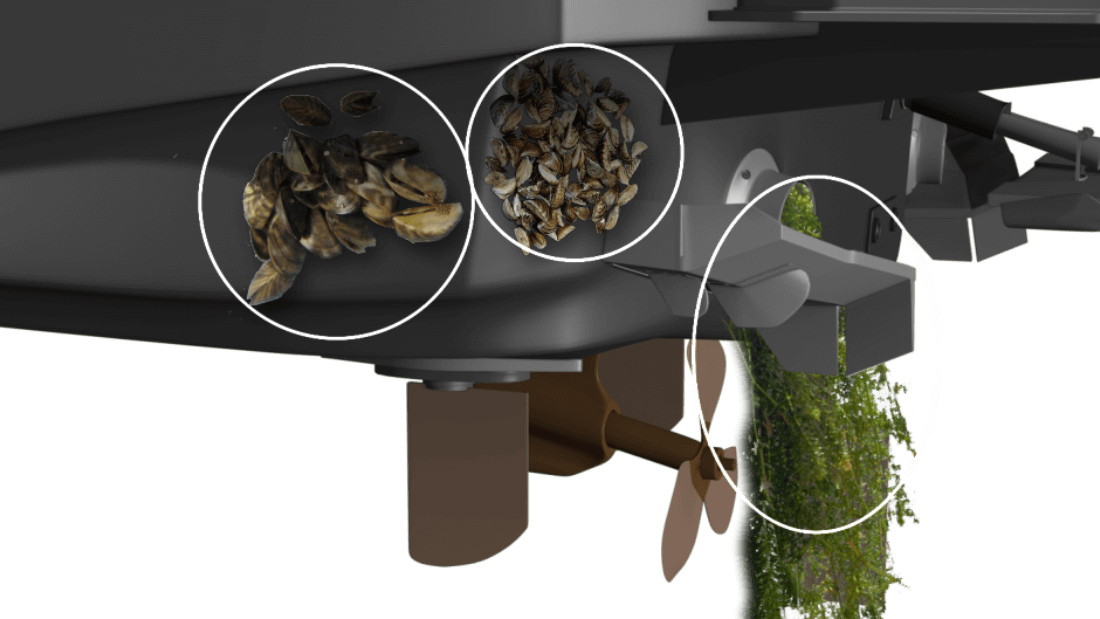Aquatic Nuisance Species (ANS) in North Carolina

Introducing non-native species into state or federally controlled waters can upset the ecosystem and hurt the environment by clogging waterways and crowding out native species.
You can help prevent the introduction and spread of non-native species from one body of water to another by:
Take these four steps after each trip on the water:
CLEAN: Equipment of all aquatic plants, animals and mud.
DRAIN: Water from boats, live wells, bait buckets and all equipment.
DRY: All equipment thoroughly.
NEVER MOVE: Fish, plants or other organisms from one body of water to another.
We recommend that you follow these steps:
- Thoroughly check the boat and trailer for any plants or mussels.
- Drain the water from your motor.
- Thoroughly wash the hull of the watercraft, the trailer, and all equipment (high-pressure washing is recommended).
- Drain all water and dry all areas.
- Drain and dry the lower outboard unit
- Clean and dry all live-wells.
- Empty your bait bucket on land, well away from the water.
Stop the Spread of AIS
Aquatic invasive species are plants and animals introduced into waters that cause ecological and/or economic harm if established. Aquatic invasive species include whirling disease, didymo, gill lice, hydrilla, zebra mussel, giant salvinia and many others.
Zebra mussels
Zebra mussels, small, fingernail-sized mollusks native to the Caspian Sea region of Asia, are regarded as one of the most troublesome invasive species in North America. In spite of their small size, zebra mussels clog pipelines used for water filtration, render beaches unusable, and damage boats. They also negatively impact aquatic ecosystems by harming native organisms.
The zebra mussel is a small shellfish named for the striped pattern of its shell. However, color patterns can vary to the point of having only dark or light-colored shells with no stripes.
Myxobolus cerebralis
Myxobolus cerebralis (the parasite that causes whirling disease) was first confirmed in North Carolina in July 2015 from a Rainbow Trout collected from Watauga River near Foscoe, Watauga County. Whirling disease damages cartilage and skeletal tissue in a fish, causing it to swim in a whirling motion. While often fatal to juvenile fish, the disease does not infect humans or pets, and eating an infected fish is not known to cause any harmful effects. The NCWRC will continues to work with researchers to explore the distribution and life history characteristics of Myxobolus cerebralis in North Carolina.
Gill lice
In September 2014, gill lice (tiny, white copepods that attach to a fish's gills) were documented in North Carolina. Elsewhere within the United States, Salmincola edwardsii and S. californiensis are known to parasitize salmonids of the genera of Salvelinus and Oncorhynchus, respectively, and taxonomic and molecular analyses of copepods confirmed the identification of both species in the State, with S. edwardsii infecting Brook Trout and S. californiensis infecting Rainbow Trout. Gill lice can traumatize gills and inhibit the fish’s ability to breathe.
Hydrilla
Hydrilla is a submersed aquatic plant that can create nearly impenetrable mats of stems and leaves on the surface of lakes, rivers and other waterways. An invasive species from Asia, hydrilla impedes recreational use of waterways, crowds out native vegetation and can ultimately harm fish and other aquatic species. The plant can also clog intakes where rivers or reservoirs are used for drinking water supplies and irrigation.
Help stop the spread of aquatic nuisance species.